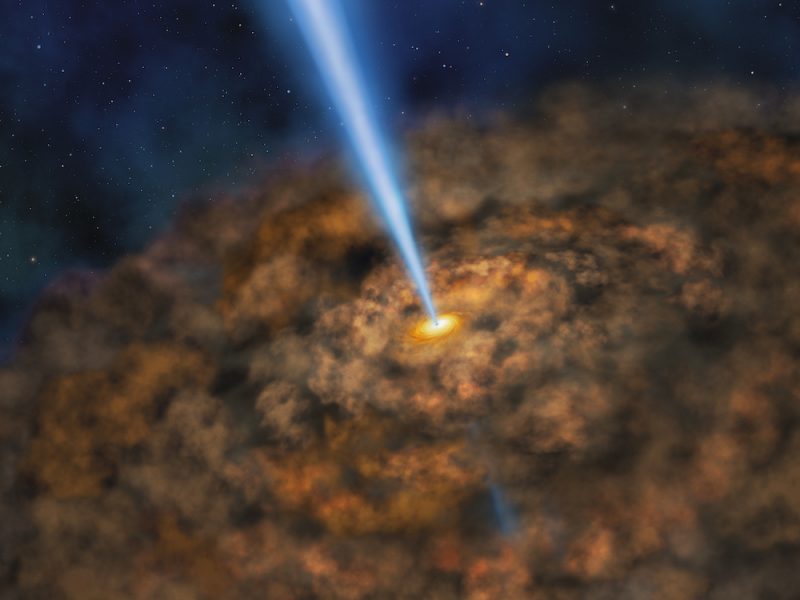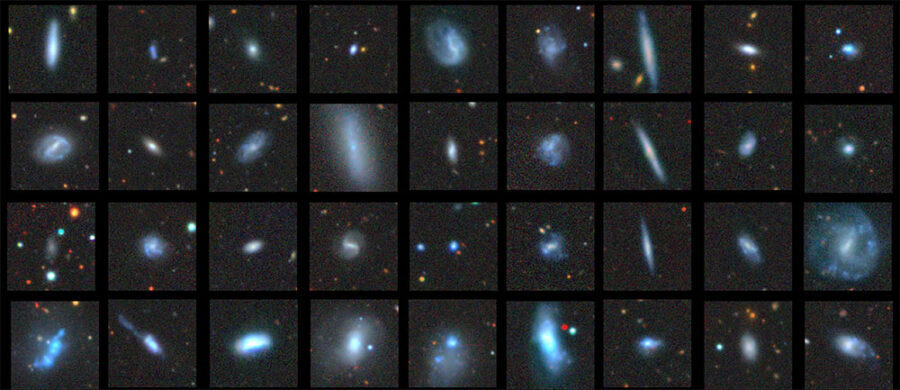Astronomers are searching nearby dwarf galaxies for the ancient origins of supermassive black holes.

NASA / SOFIA / Lynette Cook
Massive black holes in the cores of puny dwarf galaxies are much more common than previously thought, according to new results presented at an American Astronomical Society press conference Monday. The findings will help astronomers to understand how the newly born universe spawned supermassive black holes in the first place.
Most large galaxies like our own Milky Way harbor supermassive black holes, weighing in at millions or even billions of solar masses. If actively accreting material from their surroundings, they can sometimes outshine their host galaxy. Such quasars have been observed in the early universe, indicating that massive black holes grew incredibly fast from smaller “seeds.”
However, astronomers don’t know the nature of these first seeds. Maybe the growth process started with the ubiquitous remnants of the very first generation of extremely massive stars, known as Population III stars. These black hole “seeds” would have had up to about 100 times the mass of the Sun and could have gained additional bulk through subsequent collisions and mergers.
Alternatively, huge unstable masses of primordial gas could have fallen into galactic centers, directly collapsing into very massive black holes (up to a few hundred thousand solar masses) in one fell swoop.
Since the early universe is difficult to study in detail, astronomers focus on nearby dwarf galaxies. While larger galaxies like the Milky Way are the result of mergers, “dwarf galaxies have remained relatively untouched over cosmic time,” explains Mallory Molina (Montana State University). So if dwarfs host massive black holes, these provide a window into the past.
So far, a handful of giant black holes have been found in dwarf galaxies, mainly in rather massive ones with little star-forming activity. But in a December 1st paper in The Astrophysical Journal (preprint available here), a team led by Molina and Amy Reines (also at Montana State) presents evidence for the existence of supermassive black holes in 81 dwarfs that are both smaller and more actively forming stars.

Mallory Molina
Previous surveys missed these black holes because their broad visible-light emission is washed out by the stronger glow of star-forming regions. To see past the light of newborn stars, the astronomers looked for a red emission line of highly ionized iron atoms in spectroscopic data from the Sloan Digital Sky Survey for tens of thousands of dwarf galaxies. Starlight is not energetic enough to produce this extreme level of ionization, but X-rays from hot gas blown away by a central black hole can do the trick.
The team’s systematic search only revealed active black holes, so the total percentage of dwarf galaxies harboring supermassive black holes is still unknown. “That’s the million-dollar question in the field,” says Molina. “What we have found is only the tip of the iceberg.” Still, the new result has implications for our ideas about the growth of supermassive black holes in the early universe.
As Ryan Hickox (Dartmouth College) explains, the direct collapse scenario cannot have been very common. “It’s hard to compress large volumes of gas in a tiny region of space, as they would tend to fragment,” he says. So the more supermassive black holes you find in dwarf galaxies, the less likely it is that they are all due to direct collapse.

X-ray: NASA / CXC / Dartmouth Coll. / J. Parker & R. Hickox; Optical / IR: Pan-STARRS
At the same press conference, Hickox presented unpublished Chandra X-ray Observatory data of the dwarf galaxy Markarian 462, which indicate the presence of a supermassive black hole heavily obscured by dust. “This is one of the first obscured black holes in a dwarf galaxy,” he says. “Such objects might have been missed so far in earlier surveys, so this also points to a much larger population.”
“Both studies seem to support the idea that big black holes are actually pretty common in dwarf galaxies, just harder to detect than supermassive black holes in ‘normal’-size galaxies,” says Sera Markoff (University of Amsterdam), who was not involved in either study. “And that would favor the Population III model [for the origin of supermassive black holes], although it’s still a big problem how exactly they would grow so fast.”
Unfortunately, observations of dwarf galaxies in the local universe are not going to entirely answer the question of the origin of supermassive black holes. “Although growth from smaller seeds now starts to look like the more reasonable scenario,” Molina says, “what we really need is to watch their formation in the early universe. The James Webb Space Telescope may finally nail it down.”
 0
0









Comments
You must be logged in to post a comment.